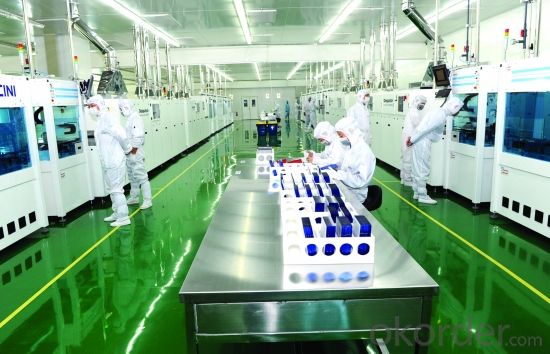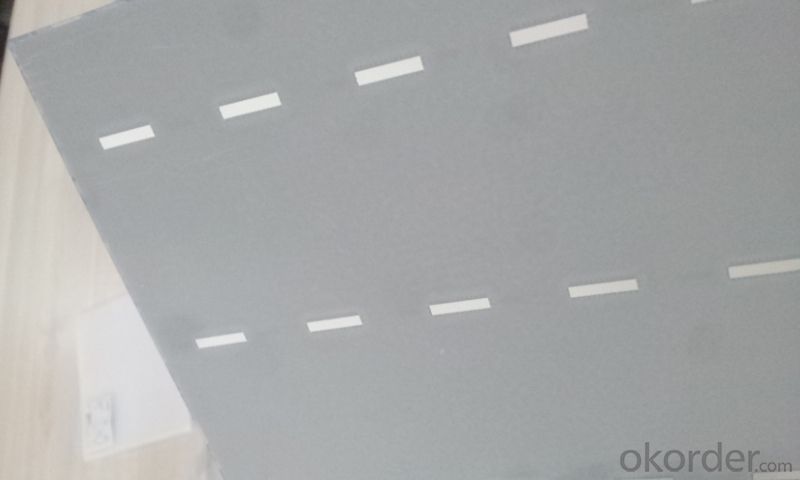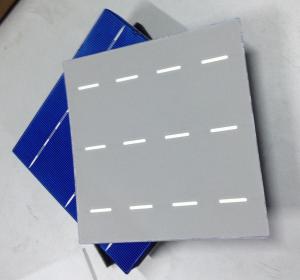Portable Solar Cells Camping - Polycrystalline Solar Cells Tire 1 Manufacturer in China - 17.40%
- Loading Port:
- Shanghai
- Payment Terms:
- TT OR LC
- Min Order Qty:
- 10000 watt
- Supply Capability:
- 500000 watt/month
OKorder Service Pledge
OKorder Financial Service
You Might Also Like
Brief Introduction of Solar Cells
A solar cell, is an electrical device that converts the energy of light directly into electricity by the photovoltaic effect, which is a physical and chemical phenomenon. It is a form of photoelectric cell, defined as a device whose electrical characteristics, such as current, voltage, or resistance, vary when exposed to light. Solar cells are the building blocks of photovoltaic modules, otherwise known as solar panels.
Specifications of Polycrystalline Solar Cells
Format : 156 mm × 156 mm ± 0.5 mm
Thickness: 210 μm ±40 μm
Front (-) : 1.5mm bus bars (silver),blue anti-reflection coating (silicon nitride)
Back (+) : 2.5mm wide soldering pads (silver) back surface field (aluminium)
Efficiency (%) | Pmpp (W) | Umpp (V) | Impp (A) | Voc (V) | Isc (A) |
18.00% | 4.38 | 0.528 | 8.291 | 0.631 | 8.869 |
17.80% | 4.33 | 0.525 | 8.252 | 0.629 | 8.821 |
17.60% | 4.29 | 0.532 | 8.053 | 0.633 | 8.541 |
17.40% | 4.23 | 0.528 | 8.092 | 0.624 | 8.632 |
17.20% | 4.19 | 0.524 | 7.992 | 0.62 | 8.458 |
17.00% | 4.14 | 0.52 | 7.972 | 0.623 | 8.5 |
Advantage of Polycrystalline Solar Cells
1. High efficiency and High power.
2. Long-term electrical stability.
3. Lowest price and Fastest delivery.
4. Good quality and good service.
5.Bulk supply
6. Good Warranty
7.Big Sale
8.Made in Taiwan/Germany etc for high quality
9.More than 35 years on the lifetime.
10 DHL/Fedex/UPS/TNT/EMS etc
11 Taiwan/Germany CO provided
Usage of Polycrystalline Solar Cells
Solar cells are often electrically connected and encapsulated as a module. Photovoltaic modules often have a sheet of glass on the front (sun up) side, allowing light to pass while protecting the semiconductor wafers from abrasion and impact due to wind-driven debris, rain, hail, etc. Solar cells are also usually connected in series in modules, creating an additive voltage. Connecting cells in parallel will yield a higher current; our solar cells have passed IEC Certification. With high and stable quality, our cells can greatly improve the performance of Solar Modules.
Applications of Polycrystalline Solar Cells
Assemblies of photovoltaic cells are used to make solar modules which generate electrical power from sunlight, as distinguished from a "solar module" or "solar panel". A solar array generates solar power using solar energy.
Packaging & Delivery of Polycrystalline Solar Cells
Carton Box Package and Deliver by air. It should be noticed that it should be avoid of water, sunshine and moist.
Factory Picture of Solar Cells



FAQ
We have organized several common questions for our clients,may help you sincerely:
1. What’s price per watt?
A: It’s depends on the quantity, delivery date and payment terms of the order. We can talk further about the detail price issue. Our products is high quality with lower price level.
2. Can you tell me the parameter of your solar cells?
We have different series of cells with different power output, both from c-si to a-si. Please take our specification sheet for your reference.
3. How do you pack your products?
We have rich experience on how to pack the panels to make sure the safety on shipment when it arrives at the destination.
4. Can you do OEM for us?
Yes, we can.
5. How long can we receive the product after purchase?
In the purchase of product within three working days, We will arrange the factory delivery as soon as possible. The perfect time of receiving is related to the state and position of customers. Commonly 7 to 10 working days can be served.
- Q: How do solar cells contribute to reducing greenhouse gas emissions?
- Solar cells contribute to reducing greenhouse gas emissions by generating electricity from sunlight, a renewable and clean source of energy. By harnessing solar power, solar cells eliminate the need for conventional fossil fuel-based electricity generation methods, such as burning coal or natural gas, which release large amounts of greenhouse gases into the atmosphere. Therefore, the widespread adoption of solar cells helps decrease our dependence on fossil fuels, mitigates climate change, and contributes to a more sustainable future.
- Q: How much maintenance do solar cells require?
- Solar cells require very little maintenance. They are designed to be durable and require minimal attention once installed. Regular cleaning to remove dust and debris is recommended, and occasional inspections to ensure proper functioning are advisable. Other than that, solar cells are known for their long lifespan and low maintenance requirements.
- Q: How do solar cells perform in areas with high levels of insect activity?
- Solar cells can still perform well in areas with high levels of insect activity. However, the efficiency of solar cells might be slightly affected if there is a significant accumulation of dust, debris, or insect droppings on the surface of the panels. Regular cleaning and maintenance can help mitigate any potential impact and ensure optimal performance.
- Q: What is the effect of shading on solar cell performance?
- The effect of shading on solar cell performance is significant as it can substantially reduce the overall power output of the solar panel. When even a small portion of the solar cell is shaded, it creates a bottleneck for the flow of current, which can lead to a decrease in the voltage and current output. Shading can cause hotspots to form on the shaded cells, resulting in potential damage or reduced efficiency. Therefore, it is crucial to minimize shading on solar panels to maximize their performance and overall energy generation.
- Q: Can solar cells be used for powering data centers?
- Yes, solar cells can be used to power data centers. Solar energy can be harnessed through photovoltaic panels to generate electricity which can then be used to power the infrastructure of data centers. This renewable energy source can help reduce the carbon footprint and dependency on fossil fuels, making data centers more sustainable and environmentally friendly.
- Q: Can solar cells be used for heating?
- Yes, solar cells can be used for heating through the use of solar thermal collectors. These collectors capture the sun's energy and convert it into heat, which can then be used for various heating purposes such as heating water or indoor spaces.
- Q: Where can I find more information about the work process of solar cells
- Though the scientific website by searching solar cell work process.
- Q: Can solar cells be used for refrigeration?
- Yes, solar cells can be used for refrigeration. By converting sunlight into electricity, solar cells can power refrigeration systems that use the electricity to cool and maintain a low temperature. This is particularly useful in areas with limited access to electricity grids or during power outages, where solar-powered refrigeration can provide a sustainable and reliable cooling solution.
- Q: My solar cells are broken, can I just buy one and replace it?
- It's a bit risky to do that by yourself.
- Q: Can somebody list some of the materials used for making solar cells?
- Silicon is one of the most important and expensive materials to make solar cells.
Send your message to us
Portable Solar Cells Camping - Polycrystalline Solar Cells Tire 1 Manufacturer in China - 17.40%
- Loading Port:
- Shanghai
- Payment Terms:
- TT OR LC
- Min Order Qty:
- 10000 watt
- Supply Capability:
- 500000 watt/month
OKorder Service Pledge
OKorder Financial Service
Similar products
Hot products
Hot Searches
Related keywords




























